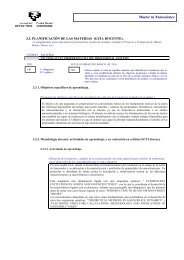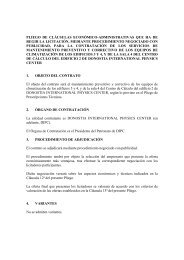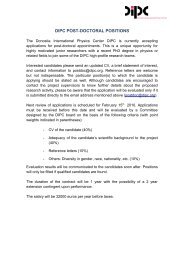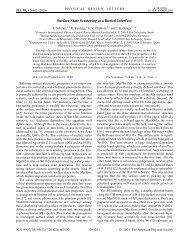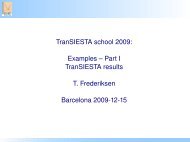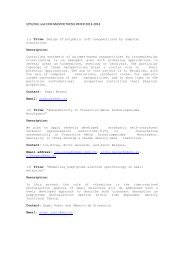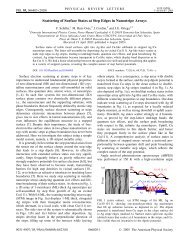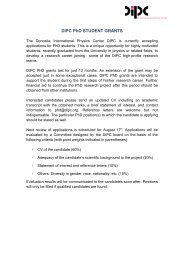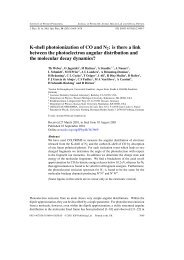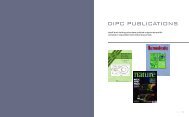Complete report - Donostia International Physics Center - Euskal ...
Complete report - Donostia International Physics Center - Euskal ...
Complete report - Donostia International Physics Center - Euskal ...
You also want an ePaper? Increase the reach of your titles
YUMPU automatically turns print PDFs into web optimized ePapers that Google loves.
2010 DIPC Highlight<br />
A versatile “click” chemistry<br />
precursor of functional polystyrene<br />
nanoparticles<br />
L. Oria, R. Aguado, J.A. Pomposo, and J. Colmenero<br />
Advanced Materials 22, 3038 (2010)<br />
Highly efficient routes to well-defined single-chain nanoparticles with size below 10 nm are really<br />
scarce. Recently, we have <strong>report</strong>ed the facile synthesis of a versatile “click” chemistry precursor<br />
of ultra-small polystyrene single-chain nanoparticles (size ≈4 nm).<br />
Functional nanoparticles (NPs) are becoming important building blocks in the emerging fields of<br />
nanomedicine, nanolithography and nanoelectronics, among others. In recent years several unexpected<br />
nano-scale effects have been discovered for these new materials. However, useful synthetic routes to<br />
single-molecule polymeric NPs in the 2–15 nm size range are certainly scarce in spite of the enormous<br />
potential predicted for these materials. In this sense, the main requirements for a versatile synthetic route<br />
to single-chain cross-linked polymeric NPs are: i) easy incorporation of coupling precursors into the individual<br />
polymer chains, ii) highly efficient and selective cross-linking (coupling) reaction, and iii) appropriate<br />
room temperature reaction conditions favoring intramolecular coupling versus intermolecular cross-linking.<br />
Figure 1. Illustration of the “click” chemisty concept: in the present of a copper-catalyst, azide group (blue color)<br />
reacts very fast with alkyne group (grey color) to give a triazole ring.<br />
A versatile “click” chemistry precursor of ultra-small functional polystyrene<br />
nanoparticles (size ≈4 nm) has been synthesized.<br />
In recent years, exquisite control over the composition, molecular weight and molecular weight distribution<br />
of synthetic macromolecules (including block and random copolymers) has been achieved using<br />
(user-friendly) controlled/living radical polymerization techniques, such as reversible addition-fragmentation<br />
chain transfer (RAFT) polymerization. Additionally, “click” chemistry methodologies and specifically<br />
the copper-catalyzed cycloaddition of alkynes and azides (Figure 1) are currently being used in polymer<br />
and materials science for easy and almost quantitative functionalization of synthetic polymers, biomolecules<br />
and inorganic nanoparticles. In fact, the combination of RAFT polymerization and “click” chemistry<br />
meets all the above requirements for the synthesis of well-defined single-chain cross-linked polymeric NPs.<br />
(A)<br />
(B)<br />
Recently, we have “mise-a-point” the synthesis of a new and versatile “click” chemistry precursor of functional<br />
polystyrene nanoparticles (PS-NPs) by the combination of RAFT copolymerization and a subsequent<br />
very efficient functionalization step. This procedure allows the preparation of the “clickable” nanoparticleprecursor<br />
starting from a simple styrene copolymer, opening the way to PS-NPs that could be potentially<br />
used as processing additives or fluorescent contrast agents, among other applications. As illustrated in<br />
Figure 2 (A), a significant viscosity drop was found in nanocomposites of neat natural rubber (cis-1,4-polyisoprene)<br />
and ultra-small functional PS-NPs at very low NP content. In fact, this is the first <strong>report</strong> of rubber<br />
nanocomposites with reduced melt viscosity arising from the presence of well-dispersed individual polymeric<br />
NPs. In addition, Figure 2 (B) demonstrates the useful fluorescence emission properties of ultrasmall<br />
PS-NPs.<br />
Figure 2. Illustration of the properties of ultra-small functional polystyrene nanoparticles (size ≈4 nm): (A) as processing<br />
additives, inducing a significant viscosity drop in neat natural rubber (cis-1,4-polyisoprene); (B) as fluorescent<br />
contrast agents, showing a strong fluorescence emission band with two clear peaks at 391 and 407 nm.<br />
30 DIPC 10/11<br />
DIPC 10/11 31



